Date : March 25, 2013
Notice: Press Tour “New Relations between Welfare for the Disabled and Art, in Yokohama” (March 25, 2013)
post date : 2013.08.22
 Art produced by the disabled has been getting people’s attention in recent years. Systems have been created so that such art works are incorporated into the designs of clothes and sundries, and bought at department stores or on the Internet by many more people. Some of these products gain high evaluation of consumers and are hard-to-get.
Art produced by the disabled has been getting people’s attention in recent years. Systems have been created so that such art works are incorporated into the designs of clothes and sundries, and bought at department stores or on the Internet by many more people. Some of these products gain high evaluation of consumers and are hard-to-get.
Art works created by the handicapped are called “Able Art” or “Art Brut (raw art or rough art)”; art experts of the world have been giving fervent attention to them. “Art Brut Japonais,” an exhibition held from March 2010 to January 2011 in Paris, exhibited works of 63 invited Japanese Art Brut artists and became very popular, recording about 120,000 visitors. This success contributed to higher interest in Japan.
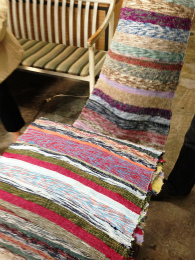 Yokohama City, aiming to be a cultural creative city, has been making efforts to use the “creativity” of arts and culture for city-building and for the solution of social issues. The city has been working on the “Yokohama Rendez-vous Project,” with a view to creating a new system to come up with new products, linking facilities for the disabled in Yokohama with leading-edge professional designers. This collaboration has resulted in “SLOW LABEL,” a brand for miscellaneous goods. One example: A designer visited a facility for the handicapped, got an inspiration from a fabric he saw there, and designed a bag with his own characteristics. Hand-woven fabrics made individually by the disabled have such different color-use and patterns that no two products are the same. These one-of-a-kind goods made slowly and carefully are very popular; they are on sale even at expensive department stores. Goods produced at facilities for the handicapped used to be sold only at such limited events as bazaars. As these products are now available in major markets, those who use such facilities are now able to have much contact with society, which is giving them a stronger incentive for life.
Yokohama City, aiming to be a cultural creative city, has been making efforts to use the “creativity” of arts and culture for city-building and for the solution of social issues. The city has been working on the “Yokohama Rendez-vous Project,” with a view to creating a new system to come up with new products, linking facilities for the disabled in Yokohama with leading-edge professional designers. This collaboration has resulted in “SLOW LABEL,” a brand for miscellaneous goods. One example: A designer visited a facility for the handicapped, got an inspiration from a fabric he saw there, and designed a bag with his own characteristics. Hand-woven fabrics made individually by the disabled have such different color-use and patterns that no two products are the same. These one-of-a-kind goods made slowly and carefully are very popular; they are on sale even at expensive department stores. Goods produced at facilities for the handicapped used to be sold only at such limited events as bazaars. As these products are now available in major markets, those who use such facilities are now able to have much contact with society, which is giving them a stronger incentive for life.
The tour will be briefed by the director of “Yokohama Rendez-vous Project/SLOW LABEL” and visit a facility for the disabled which participates in the project, interview some disabled persons, and observe their making goods. It will also visit another facility which is actively using art for the disabled who come to it, and cover a handicapped but active artist whose works have been used for the designs of book covers and textiles.
Through this coverage the tour will examine the new relation between disabled and art and how the disabled become active participants in society through art.
*The tour is hosted by Yokohama City with FPCJ’s cooperation in planning and operation.
1.The Yokohama Rendez-vous Project「SLOW LABEL」
~A new manufacturing brand links disabled people and designers~
http://www.slowlabel.info/ The Yokohama Rendez-vous Project was started in 2009 based in Yokohama. This project links disabled people and companies in Yokohama City, and artists who work globally, and takes advantage of each of their characteristics and strengths in manufacturing. “SLOW LABEL” is a handmade products brand which was born as part of the project. Mr. Mitsushi Yanaihara, one of the fashion designers participating in “SLOW LABEL”, visited “Kaze-no-bird”, a facility for the disabled, and discovered colorful fabrics which are woven with thread expressing the mood of the people working there.
The Yokohama Rendez-vous Project was started in 2009 based in Yokohama. This project links disabled people and companies in Yokohama City, and artists who work globally, and takes advantage of each of their characteristics and strengths in manufacturing. “SLOW LABEL” is a handmade products brand which was born as part of the project. Mr. Mitsushi Yanaihara, one of the fashion designers participating in “SLOW LABEL”, visited “Kaze-no-bird”, a facility for the disabled, and discovered colorful fabrics which are woven with thread expressing the mood of the people working there.
Mr. Yanaihara designed a bag from the fabric they made, as he was inspired from their styles of weaving the threads tenderly one by one, taking enough time. He said, “I would like customers to buy the time those people spent on weaving, together with this bag.” These bags are selling in the famous department stores in Yokohama City and Tokyo, and are becoming popular hit. Ms. Yoshie Kurisu, director of “SLOW LABEL” said, “These are things that only handmade products can achieve, but in mass production. And the value of manufacturing will be changing steadily in the several years.” Ms. Kurisu has an acquired disability herself, and says “It is comfortable for me to be speaking with people in a facility for the disabled during the work, as I have a disability myself.”
The tour will visit ZOU-NO-HANA Terrace, the headquarters of this project, a facility of Yokohama City, and cover the scene of a manufacturing experience event that enables citizens and disabled people to join together. We will also hear a brief overview of this project from Ms. Yoshie Kurisu, director of SLOW LABEL.

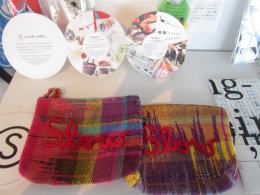

2. Kaze-no-bird, an institution for handicapped people (managed by NPO Sora)
~Textiles woven in original “colors” and popular bags enhancing disabled people’s motivation and expanding their contacts with society~
 Kaze-no-bird, managed by NPO Sora, is one of the working institutions for the disabled that are participating in the SLOW LABEL project, and 16 people are working at the institution. In collaboration with the fashion designer Mitsushi Yanaihara, they are making colorful textile materials for bags. Disabled people and staff of the institution participated from the planning stage, and the colors and patterns are not indicated by Mr. Yanaihara but put in the hands of disabled workers.
Kaze-no-bird, managed by NPO Sora, is one of the working institutions for the disabled that are participating in the SLOW LABEL project, and 16 people are working at the institution. In collaboration with the fashion designer Mitsushi Yanaihara, they are making colorful textile materials for bags. Disabled people and staff of the institution participated from the planning stage, and the colors and patterns are not indicated by Mr. Yanaihara but put in the hands of disabled workers.
The woven textiles are all original and different, reflecting the characteristics and mood of the weavers, and all look charming. One-of-a-kind bags made from these textiles are so popular that the production of textile materials can hardly keep up. “The bags have become very popular and the disabled workers have become surprisingly full of motivation. The project is called SLOW LABEL but their work has become fast. Their faces have also changed since they are so happy to see their products being sold at large department stores like Takashimaya. There used to be a limitation on our design and planning, and the products were sold only at bazaars and exhibitions, but now with the help of a professional designer, we can make beautiful products available for ordinary people. It is important for handicapped people to go to a workplace every day to get into a kind of rhythm of the day, so the workplace has to be a place they want to go to. In this sense, our project is meaningful,” says Ms. Hiroko Kurihara, a staff member of Kaze-no-bird. Participating in the project has expanded the contacts of disabled people with society.
The tour will visit Kaze-no-bird, and interview Ms. Yukiko Kaneko, President of NPO Sora, staff of Kaze-no-bird, and disabled workers.

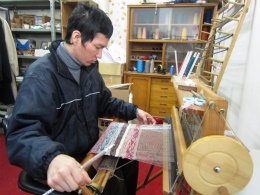
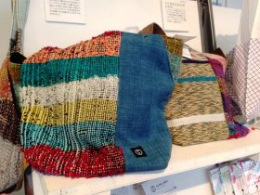
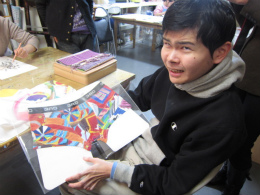 3.“Art Karen,” facility for the disabled (Operated by social welfare service corporation, Karen)
3.“Art Karen,” facility for the disabled (Operated by social welfare service corporation, Karen)
~Flourishing of “Able Art” artists now attracting art industry. Designing book covers and textile ~
http://karen.or.jp/art/artkaren-top.htm
“Art Karen,” a disabled facility operated by social welfare service corporation Karen, is carrying out creative work such as painting, needlework, hand-weaving, and planning and coordinating gallery operations. It also has a self-reliance support program, including assisting cooking lunch, cleaning, and shopping. 11 people with such disabilities as autism are commuting to this facility, and carrying out creative work just as they wish.
The vivid color artwork of one of the facility members, Mr. Ryo Isobe, 31, has been used for book covers, a handkerchief of worldwode fashion label, the textile designs of men’s underwear. The artist “RYO Isobe” is flourishing with his work, and the underwear with the motifs of his paintings is selling in a major department store. (*“Able Art Company,” which aims to create new jobs for disabled people, assisting at getting their artwork into commercial products, and setting up opportunities of utilizing their work as designs, is taking part in the effort to realize his project.)
Another member of this facility, Ms. Yuki Kawado, 28, started her work with embroidery, and now performs creative work in video and art painting. Her video work, unique and full of humor, is created based on sequential filming of her own paintings. Her video work was exhibited at “TOUCH OF IMAGE” in Yokohama, 2011, along with other contemporary artists’ work including a participant of the Venice Biennale.
Ms. Yoshie Minami, facility manager of Art Karen, said “Ms. Kawado seemed uncomfortable communicating with others when she first came here. But she became settled as she started working on her creative activities.” Her work won the prize of “Audience Awards,” which is selected from visitor’s votes in the national public exhibition “Pocorart 2013”. From among 1332 artworks subscribed, only 214 were exhibited.
This tour will visit Art Karen and hear an overview of the facility from Ms. Yoshie Minami, facility manager, and interview the facility members working as an artists, including Mr. Ryo Isobe.
We will also have lunch at “Café More” operated by the social welfare service corporation Karen, where disabled people are working.

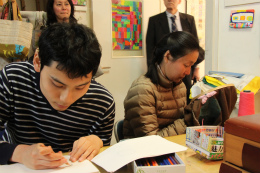
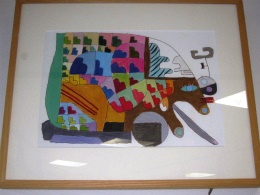
<Tour itinerary and application details>
1. Itinerary: Monday, March 25, 2013
10:15 Meet at Okurayama Station, Tokyu Toyoko Line (in front of the entrance gate)
10:30-11:45 “Art Karen,” an institution for the handicapped people
(Social welfare service corporation Karen)
・Ms. Yoshie Minami, Facility Chief
・Mr. Ryo Isobe, Artist/participant of Karen
See their studio
12:00-12:45 Lunch at “Café More” (Social welfare service corporation Karen)
13:15-14:00 Yokohama Rendez-vous Project (Zo- No-Hana Terrace)
・Mr. Yuichi Shintani, Assistant Manager for Creative City Planning,
Creative City Promotion Division, Culture and Tourism Bureau, City of Yokohama
・Ms. Yoshie Kurisu, Director, SLOW LABEL
・Totsuka Wakaba (Local non-residential ativity center for people with acquired disabilities)
http://www.city.yokohama.lg.jp/totsuka/service/chutoshougai-wakaba.html
・Konan Fukushi Home (ability-enhancing-type local activity home)
14:15-15:15 ”Kaze no Bird,” an institution for handicapped people (NPO Sora)
・Ms. Yukiko Kaneko, President
・Mr. Koichi Konnai, Facility Chief
・Ms. Hiroko Kurihara, a staff member
・Mr. Masanori Yamaguchi,
weaver/participant of the “SLOW LABEL” project
See the working process
2. Qualification: Bearer of Gaimusho Press Registration Card
3. Cost: about 1,000 yen for lunch (The money will be collected on the tour)
4. Participants: Limited to the 10 applicants
(Only one reporter and one photographer from each company, but two participants from each TV team will be acceptable.)
If the number of applicants exceeds 10, an upper limit may be set on the number of participants from each country.
5. FPCJ Contact: Ms. Yoshida (Tel: 03-3501-3405)
6. Remarks:
(1) There may be some restrictions on photographing and filming at the tour sites. Please follow the instructions of the officials on duty.
(2) FPCJ and the City of Yokohama will not be liable for any inconvenience, trouble or accident that might occur in the course of the tour.



